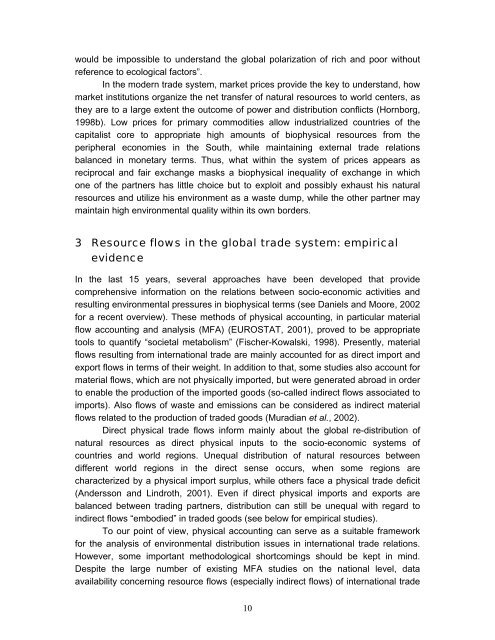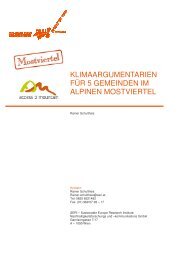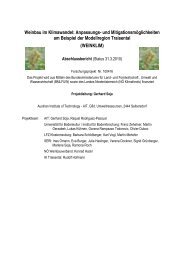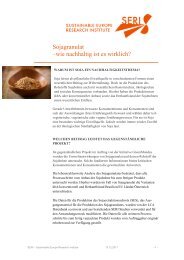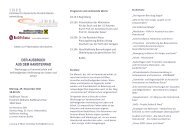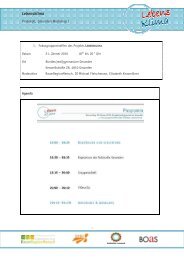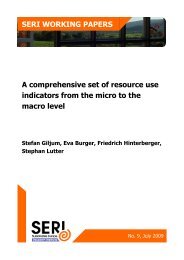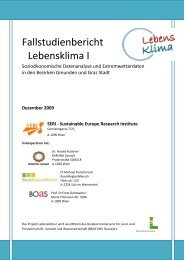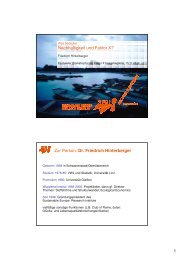Download PDF - Sustainable Europe Research Institute
Download PDF - Sustainable Europe Research Institute
Download PDF - Sustainable Europe Research Institute
You also want an ePaper? Increase the reach of your titles
YUMPU automatically turns print PDFs into web optimized ePapers that Google loves.
would be impossible to understand the global polarization of rich and poor without<br />
reference to ecological factors”.<br />
In the modern trade system, market prices provide the key to understand, how<br />
market institutions organize the net transfer of natural resources to world centers, as<br />
they are to a large extent the outcome of power and distribution conflicts (Hornborg,<br />
1998b). Low prices for primary commodities allow industrialized countries of the<br />
capitalist core to appropriate high amounts of biophysical resources from the<br />
peripheral economies in the South, while maintaining external trade relations<br />
balanced in monetary terms. Thus, what within the system of prices appears as<br />
reciprocal and fair exchange masks a biophysical inequality of exchange in which<br />
one of the partners has little choice but to exploit and possibly exhaust his natural<br />
resources and utilize his environment as a waste dump, while the other partner may<br />
maintain high environmental quality within its own borders.<br />
3 Resource flows in the global trade system: empirical<br />
evidence<br />
In the last 15 years, several approaches have been developed that provide<br />
comprehensive information on the relations between socio-economic activities and<br />
resulting environmental pressures in biophysical terms (see Daniels and Moore, 2002<br />
for a recent overview). These methods of physical accounting, in particular material<br />
flow accounting and analysis (MFA) (EUROSTAT, 2001), proved to be appropriate<br />
tools to quantify “societal metabolism” (Fischer-Kowalski, 1998). Presently, material<br />
flows resulting from international trade are mainly accounted for as direct import and<br />
export flows in terms of their weight. In addition to that, some studies also account for<br />
material flows, which are not physically imported, but were generated abroad in order<br />
to enable the production of the imported goods (so-called indirect flows associated to<br />
imports). Also flows of waste and emissions can be considered as indirect material<br />
flows related to the production of traded goods (Muradian et al., 2002).<br />
Direct physical trade flows inform mainly about the global re-distribution of<br />
natural resources as direct physical inputs to the socio-economic systems of<br />
countries and world regions. Unequal distribution of natural resources between<br />
different world regions in the direct sense occurs, when some regions are<br />
characterized by a physical import surplus, while others face a physical trade deficit<br />
(Andersson and Lindroth, 2001). Even if direct physical imports and exports are<br />
balanced between trading partners, distribution can still be unequal with regard to<br />
indirect flows “embodied” in traded goods (see below for empirical studies).<br />
To our point of view, physical accounting can serve as a suitable framework<br />
for the analysis of environmental distribution issues in international trade relations.<br />
However, some important methodological shortcomings should be kept in mind.<br />
Despite the large number of existing MFA studies on the national level, data<br />
availability concerning resource flows (especially indirect flows) of international trade<br />
10


